Hofstede’s cultural dimension : Assignment
VerifiedAdded on 2021/02/18
|12
|3664
|28
AI Summary
Contribute Materials
Your contribution can guide someone’s learning journey. Share your
documents today.

Study Skills
for
Higher Education
for
Higher Education
Secure Best Marks with AI Grader
Need help grading? Try our AI Grader for instant feedback on your assignments.
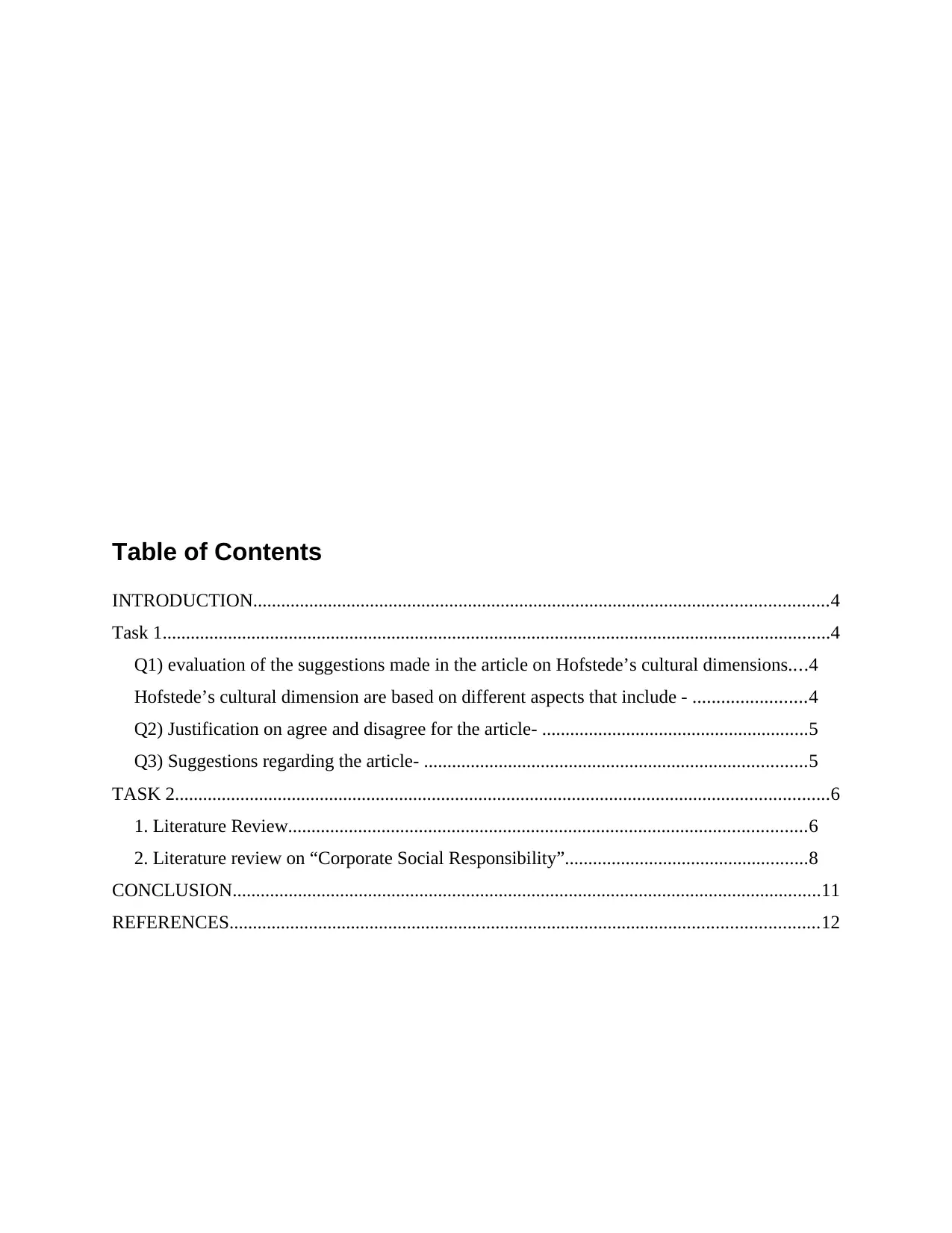
Table of Contents
INTRODUCTION...........................................................................................................................4
Task 1...............................................................................................................................................4
Q1) evaluation of the suggestions made in the article on Hofstede’s cultural dimensions....4
Hofstede’s cultural dimension are based on different aspects that include - ........................4
Q2) Justification on agree and disagree for the article- .........................................................5
Q3) Suggestions regarding the article- ..................................................................................5
TASK 2............................................................................................................................................6
1. Literature Review...............................................................................................................6
2. Literature review on “Corporate Social Responsibility”....................................................8
CONCLUSION..............................................................................................................................11
REFERENCES..............................................................................................................................12
INTRODUCTION...........................................................................................................................4
Task 1...............................................................................................................................................4
Q1) evaluation of the suggestions made in the article on Hofstede’s cultural dimensions....4
Hofstede’s cultural dimension are based on different aspects that include - ........................4
Q2) Justification on agree and disagree for the article- .........................................................5
Q3) Suggestions regarding the article- ..................................................................................5
TASK 2............................................................................................................................................6
1. Literature Review...............................................................................................................6
2. Literature review on “Corporate Social Responsibility”....................................................8
CONCLUSION..............................................................................................................................11
REFERENCES..............................................................................................................................12
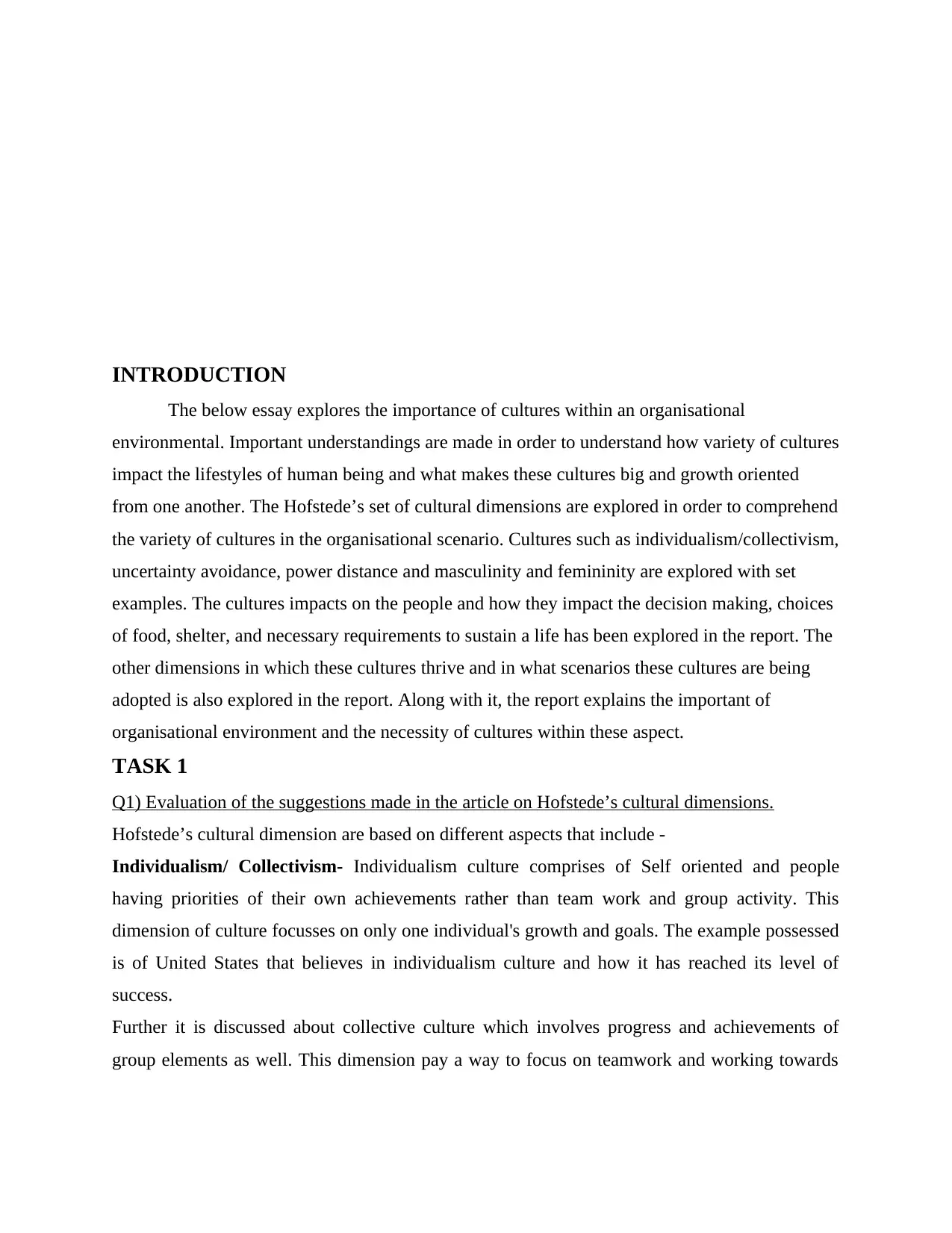
INTRODUCTION
The below essay explores the importance of cultures within an organisational
environmental. Important understandings are made in order to understand how variety of cultures
impact the lifestyles of human being and what makes these cultures big and growth oriented
from one another. The Hofstede’s set of cultural dimensions are explored in order to comprehend
the variety of cultures in the organisational scenario. Cultures such as individualism/collectivism,
uncertainty avoidance, power distance and masculinity and femininity are explored with set
examples. The cultures impacts on the people and how they impact the decision making, choices
of food, shelter, and necessary requirements to sustain a life has been explored in the report. The
other dimensions in which these cultures thrive and in what scenarios these cultures are being
adopted is also explored in the report. Along with it, the report explains the important of
organisational environment and the necessity of cultures within these aspect.
TASK 1
Q1) Evaluation of the suggestions made in the article on Hofstede’s cultural dimensions.
Hofstede’s cultural dimension are based on different aspects that include -
Individualism/ Collectivism- Individualism culture comprises of Self oriented and people
having priorities of their own achievements rather than team work and group activity. This
dimension of culture focusses on only one individual's growth and goals. The example possessed
is of United States that believes in individualism culture and how it has reached its level of
success.
Further it is discussed about collective culture which involves progress and achievements of
group elements as well. This dimension pay a way to focus on teamwork and working towards
The below essay explores the importance of cultures within an organisational
environmental. Important understandings are made in order to understand how variety of cultures
impact the lifestyles of human being and what makes these cultures big and growth oriented
from one another. The Hofstede’s set of cultural dimensions are explored in order to comprehend
the variety of cultures in the organisational scenario. Cultures such as individualism/collectivism,
uncertainty avoidance, power distance and masculinity and femininity are explored with set
examples. The cultures impacts on the people and how they impact the decision making, choices
of food, shelter, and necessary requirements to sustain a life has been explored in the report. The
other dimensions in which these cultures thrive and in what scenarios these cultures are being
adopted is also explored in the report. Along with it, the report explains the important of
organisational environment and the necessity of cultures within these aspect.
TASK 1
Q1) Evaluation of the suggestions made in the article on Hofstede’s cultural dimensions.
Hofstede’s cultural dimension are based on different aspects that include -
Individualism/ Collectivism- Individualism culture comprises of Self oriented and people
having priorities of their own achievements rather than team work and group activity. This
dimension of culture focusses on only one individual's growth and goals. The example possessed
is of United States that believes in individualism culture and how it has reached its level of
success.
Further it is discussed about collective culture which involves progress and achievements of
group elements as well. This dimension pay a way to focus on teamwork and working towards
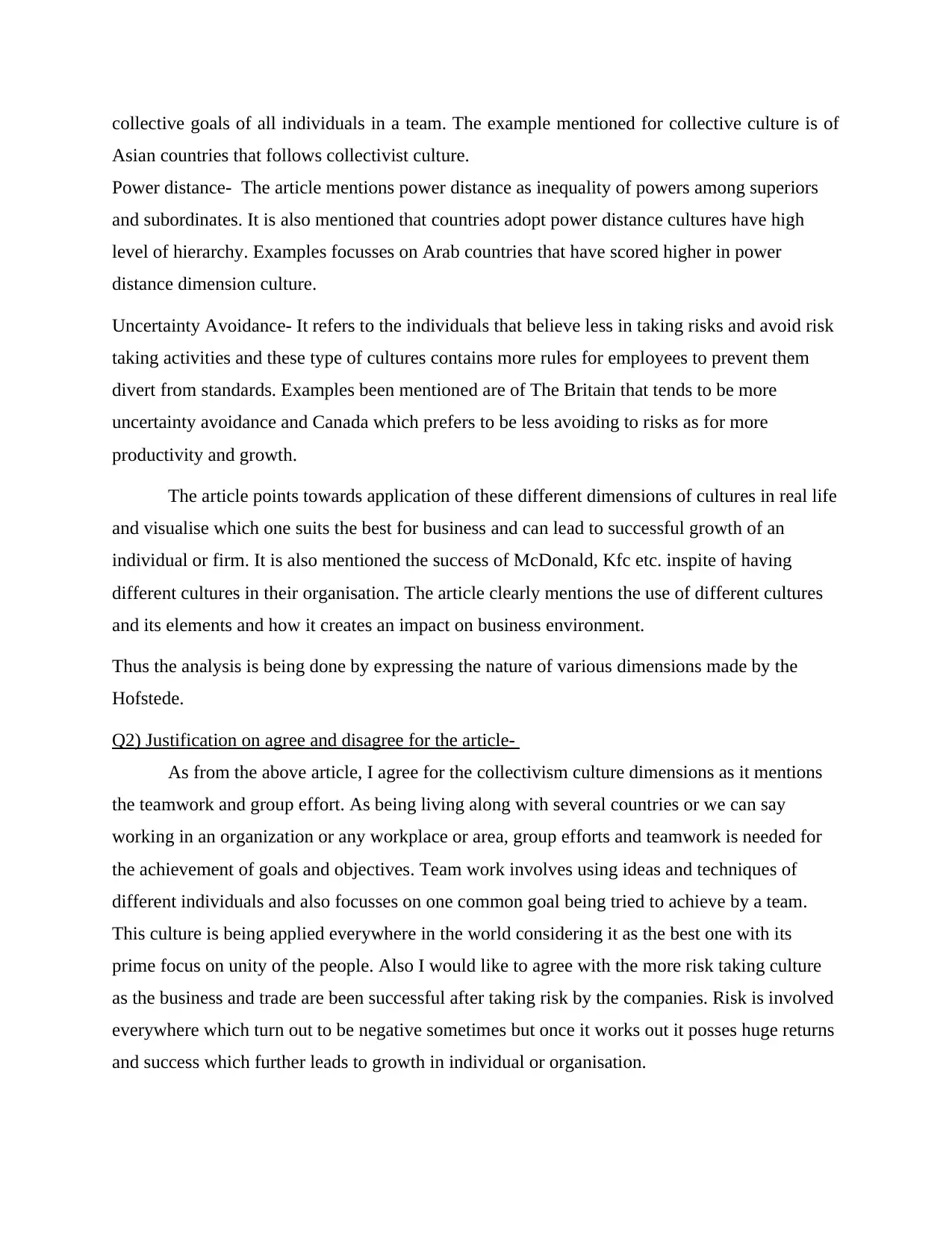
collective goals of all individuals in a team. The example mentioned for collective culture is of
Asian countries that follows collectivist culture.
Power distance- The article mentions power distance as inequality of powers among superiors
and subordinates. It is also mentioned that countries adopt power distance cultures have high
level of hierarchy. Examples focusses on Arab countries that have scored higher in power
distance dimension culture.
Uncertainty Avoidance- It refers to the individuals that believe less in taking risks and avoid risk
taking activities and these type of cultures contains more rules for employees to prevent them
divert from standards. Examples been mentioned are of The Britain that tends to be more
uncertainty avoidance and Canada which prefers to be less avoiding to risks as for more
productivity and growth.
The article points towards application of these different dimensions of cultures in real life
and visualise which one suits the best for business and can lead to successful growth of an
individual or firm. It is also mentioned the success of McDonald, Kfc etc. inspite of having
different cultures in their organisation. The article clearly mentions the use of different cultures
and its elements and how it creates an impact on business environment.
Thus the analysis is being done by expressing the nature of various dimensions made by the
Hofstede.
Q2) Justification on agree and disagree for the article-
As from the above article, I agree for the collectivism culture dimensions as it mentions
the teamwork and group effort. As being living along with several countries or we can say
working in an organization or any workplace or area, group efforts and teamwork is needed for
the achievement of goals and objectives. Team work involves using ideas and techniques of
different individuals and also focusses on one common goal being tried to achieve by a team.
This culture is being applied everywhere in the world considering it as the best one with its
prime focus on unity of the people. Also I would like to agree with the more risk taking culture
as the business and trade are been successful after taking risk by the companies. Risk is involved
everywhere which turn out to be negative sometimes but once it works out it posses huge returns
and success which further leads to growth in individual or organisation.
Asian countries that follows collectivist culture.
Power distance- The article mentions power distance as inequality of powers among superiors
and subordinates. It is also mentioned that countries adopt power distance cultures have high
level of hierarchy. Examples focusses on Arab countries that have scored higher in power
distance dimension culture.
Uncertainty Avoidance- It refers to the individuals that believe less in taking risks and avoid risk
taking activities and these type of cultures contains more rules for employees to prevent them
divert from standards. Examples been mentioned are of The Britain that tends to be more
uncertainty avoidance and Canada which prefers to be less avoiding to risks as for more
productivity and growth.
The article points towards application of these different dimensions of cultures in real life
and visualise which one suits the best for business and can lead to successful growth of an
individual or firm. It is also mentioned the success of McDonald, Kfc etc. inspite of having
different cultures in their organisation. The article clearly mentions the use of different cultures
and its elements and how it creates an impact on business environment.
Thus the analysis is being done by expressing the nature of various dimensions made by the
Hofstede.
Q2) Justification on agree and disagree for the article-
As from the above article, I agree for the collectivism culture dimensions as it mentions
the teamwork and group effort. As being living along with several countries or we can say
working in an organization or any workplace or area, group efforts and teamwork is needed for
the achievement of goals and objectives. Team work involves using ideas and techniques of
different individuals and also focusses on one common goal being tried to achieve by a team.
This culture is being applied everywhere in the world considering it as the best one with its
prime focus on unity of the people. Also I would like to agree with the more risk taking culture
as the business and trade are been successful after taking risk by the companies. Risk is involved
everywhere which turn out to be negative sometimes but once it works out it posses huge returns
and success which further leads to growth in individual or organisation.
Secure Best Marks with AI Grader
Need help grading? Try our AI Grader for instant feedback on your assignments.
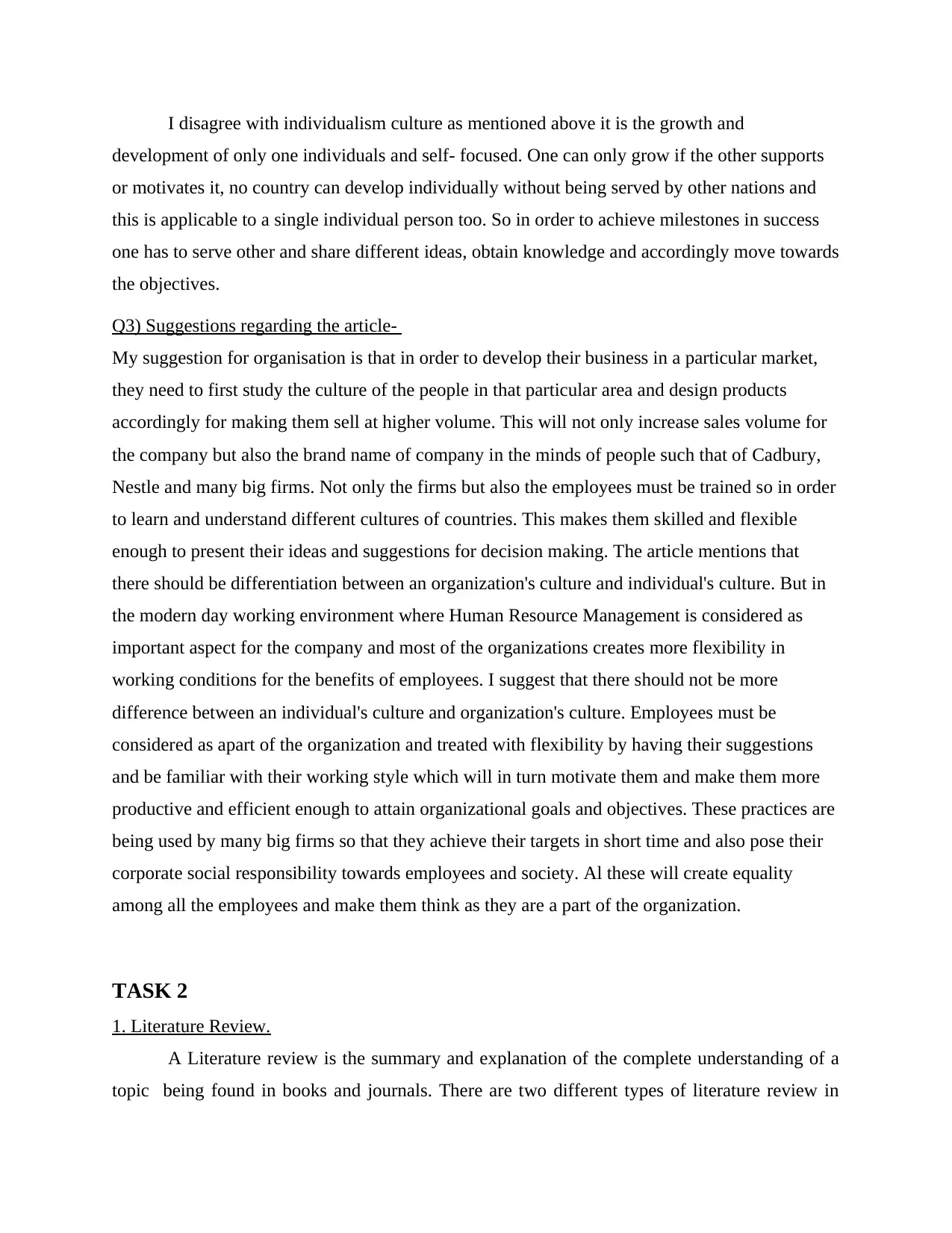
I disagree with individualism culture as mentioned above it is the growth and
development of only one individuals and self- focused. One can only grow if the other supports
or motivates it, no country can develop individually without being served by other nations and
this is applicable to a single individual person too. So in order to achieve milestones in success
one has to serve other and share different ideas, obtain knowledge and accordingly move towards
the objectives.
Q3) Suggestions regarding the article-
My suggestion for organisation is that in order to develop their business in a particular market,
they need to first study the culture of the people in that particular area and design products
accordingly for making them sell at higher volume. This will not only increase sales volume for
the company but also the brand name of company in the minds of people such that of Cadbury,
Nestle and many big firms. Not only the firms but also the employees must be trained so in order
to learn and understand different cultures of countries. This makes them skilled and flexible
enough to present their ideas and suggestions for decision making. The article mentions that
there should be differentiation between an organization's culture and individual's culture. But in
the modern day working environment where Human Resource Management is considered as
important aspect for the company and most of the organizations creates more flexibility in
working conditions for the benefits of employees. I suggest that there should not be more
difference between an individual's culture and organization's culture. Employees must be
considered as apart of the organization and treated with flexibility by having their suggestions
and be familiar with their working style which will in turn motivate them and make them more
productive and efficient enough to attain organizational goals and objectives. These practices are
being used by many big firms so that they achieve their targets in short time and also pose their
corporate social responsibility towards employees and society. Al these will create equality
among all the employees and make them think as they are a part of the organization.
TASK 2
1. Literature Review.
A Literature review is the summary and explanation of the complete understanding of a
topic being found in books and journals. There are two different types of literature review in
development of only one individuals and self- focused. One can only grow if the other supports
or motivates it, no country can develop individually without being served by other nations and
this is applicable to a single individual person too. So in order to achieve milestones in success
one has to serve other and share different ideas, obtain knowledge and accordingly move towards
the objectives.
Q3) Suggestions regarding the article-
My suggestion for organisation is that in order to develop their business in a particular market,
they need to first study the culture of the people in that particular area and design products
accordingly for making them sell at higher volume. This will not only increase sales volume for
the company but also the brand name of company in the minds of people such that of Cadbury,
Nestle and many big firms. Not only the firms but also the employees must be trained so in order
to learn and understand different cultures of countries. This makes them skilled and flexible
enough to present their ideas and suggestions for decision making. The article mentions that
there should be differentiation between an organization's culture and individual's culture. But in
the modern day working environment where Human Resource Management is considered as
important aspect for the company and most of the organizations creates more flexibility in
working conditions for the benefits of employees. I suggest that there should not be more
difference between an individual's culture and organization's culture. Employees must be
considered as apart of the organization and treated with flexibility by having their suggestions
and be familiar with their working style which will in turn motivate them and make them more
productive and efficient enough to attain organizational goals and objectives. These practices are
being used by many big firms so that they achieve their targets in short time and also pose their
corporate social responsibility towards employees and society. Al these will create equality
among all the employees and make them think as they are a part of the organization.
TASK 2
1. Literature Review.
A Literature review is the summary and explanation of the complete understanding of a
topic being found in books and journals. There are two different types of literature review in
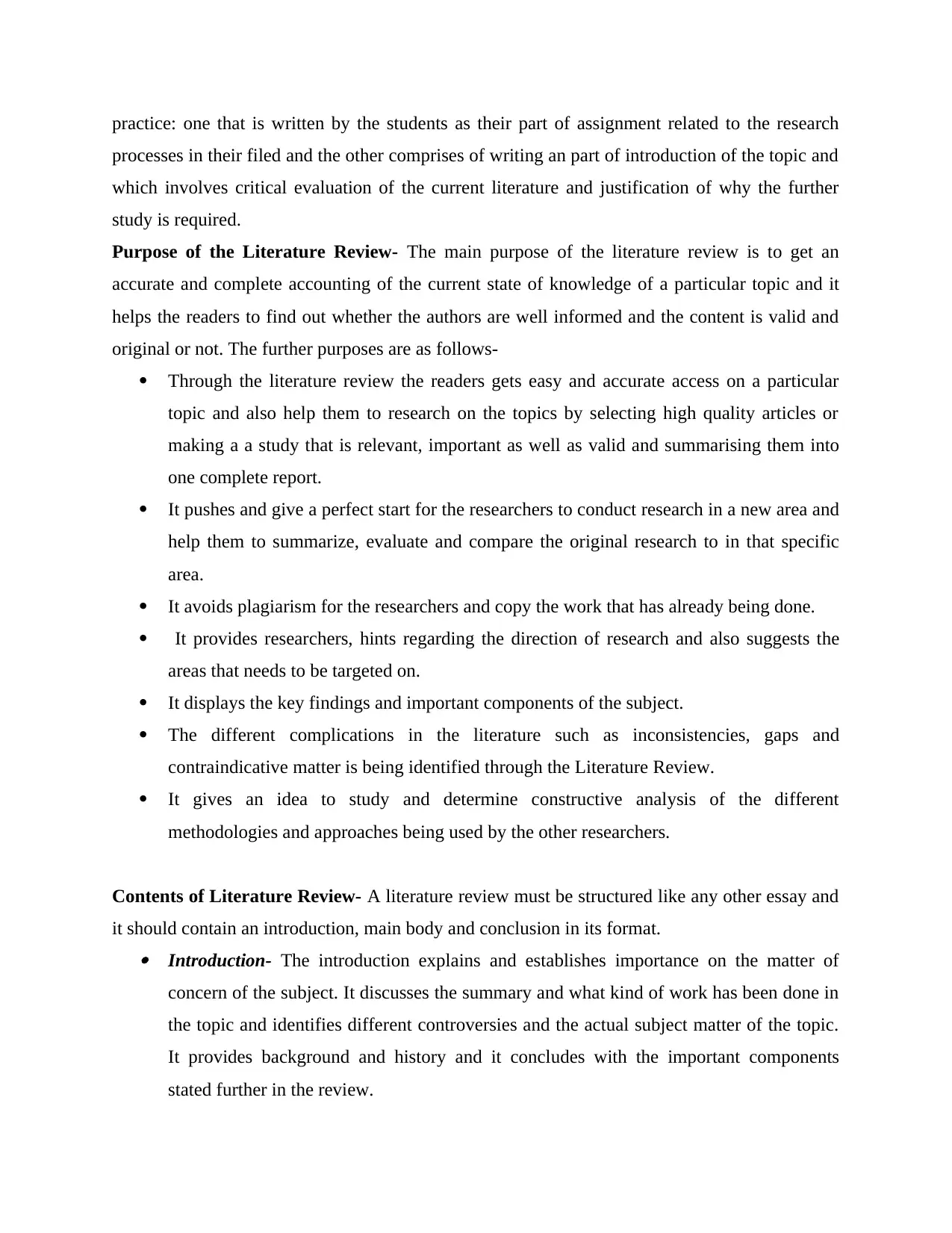
practice: one that is written by the students as their part of assignment related to the research
processes in their filed and the other comprises of writing an part of introduction of the topic and
which involves critical evaluation of the current literature and justification of why the further
study is required.
Purpose of the Literature Review- The main purpose of the literature review is to get an
accurate and complete accounting of the current state of knowledge of a particular topic and it
helps the readers to find out whether the authors are well informed and the content is valid and
original or not. The further purposes are as follows-
Through the literature review the readers gets easy and accurate access on a particular
topic and also help them to research on the topics by selecting high quality articles or
making a a study that is relevant, important as well as valid and summarising them into
one complete report.
It pushes and give a perfect start for the researchers to conduct research in a new area and
help them to summarize, evaluate and compare the original research to in that specific
area.
It avoids plagiarism for the researchers and copy the work that has already being done.
It provides researchers, hints regarding the direction of research and also suggests the
areas that needs to be targeted on.
It displays the key findings and important components of the subject.
The different complications in the literature such as inconsistencies, gaps and
contraindicative matter is being identified through the Literature Review.
It gives an idea to study and determine constructive analysis of the different
methodologies and approaches being used by the other researchers.
Contents of Literature Review- A literature review must be structured like any other essay and
it should contain an introduction, main body and conclusion in its format. Introduction- The introduction explains and establishes importance on the matter of
concern of the subject. It discusses the summary and what kind of work has been done in
the topic and identifies different controversies and the actual subject matter of the topic.
It provides background and history and it concludes with the important components
stated further in the review.
processes in their filed and the other comprises of writing an part of introduction of the topic and
which involves critical evaluation of the current literature and justification of why the further
study is required.
Purpose of the Literature Review- The main purpose of the literature review is to get an
accurate and complete accounting of the current state of knowledge of a particular topic and it
helps the readers to find out whether the authors are well informed and the content is valid and
original or not. The further purposes are as follows-
Through the literature review the readers gets easy and accurate access on a particular
topic and also help them to research on the topics by selecting high quality articles or
making a a study that is relevant, important as well as valid and summarising them into
one complete report.
It pushes and give a perfect start for the researchers to conduct research in a new area and
help them to summarize, evaluate and compare the original research to in that specific
area.
It avoids plagiarism for the researchers and copy the work that has already being done.
It provides researchers, hints regarding the direction of research and also suggests the
areas that needs to be targeted on.
It displays the key findings and important components of the subject.
The different complications in the literature such as inconsistencies, gaps and
contraindicative matter is being identified through the Literature Review.
It gives an idea to study and determine constructive analysis of the different
methodologies and approaches being used by the other researchers.
Contents of Literature Review- A literature review must be structured like any other essay and
it should contain an introduction, main body and conclusion in its format. Introduction- The introduction explains and establishes importance on the matter of
concern of the subject. It discusses the summary and what kind of work has been done in
the topic and identifies different controversies and the actual subject matter of the topic.
It provides background and history and it concludes with the important components
stated further in the review.
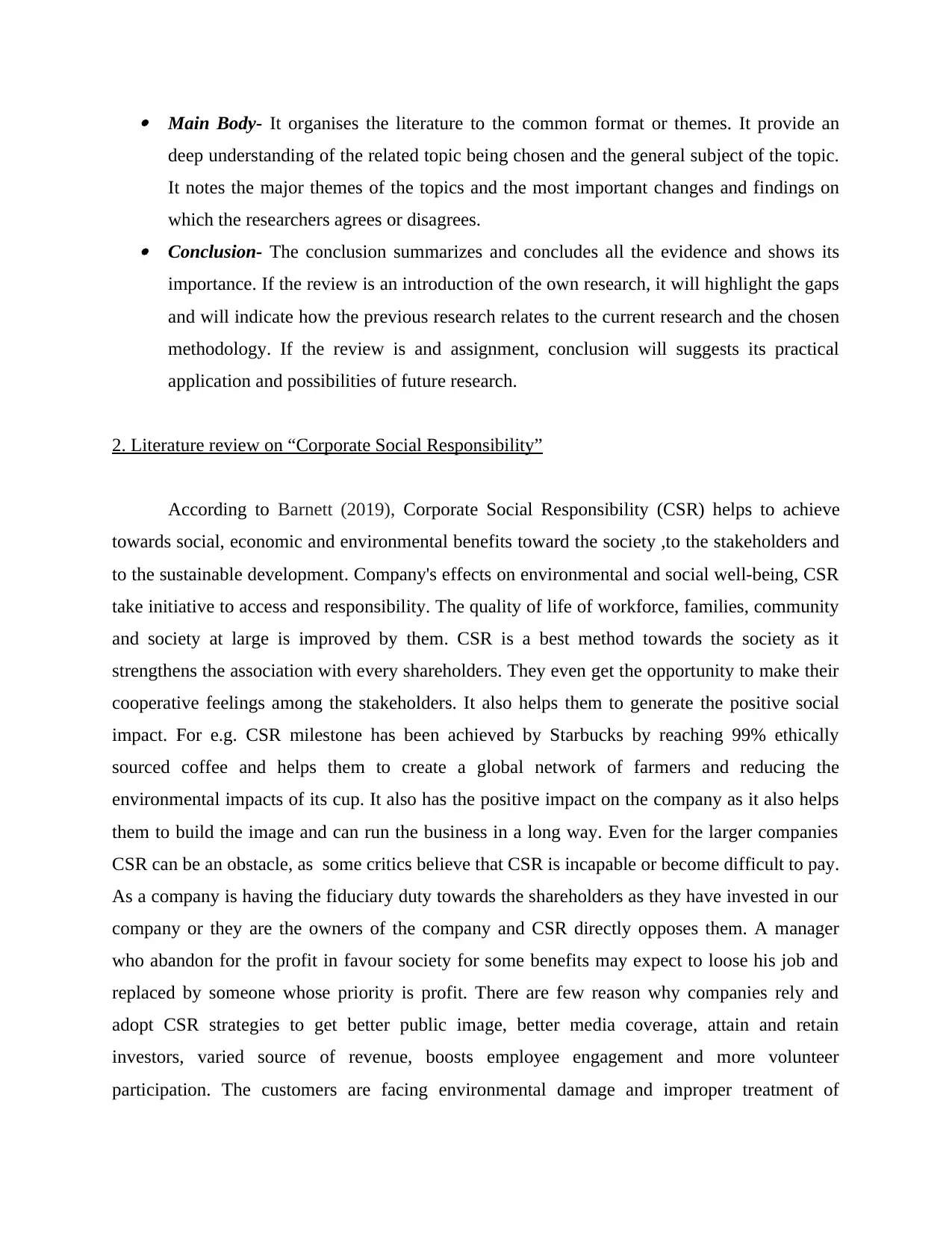
Main Body- It organises the literature to the common format or themes. It provide an
deep understanding of the related topic being chosen and the general subject of the topic.
It notes the major themes of the topics and the most important changes and findings on
which the researchers agrees or disagrees. Conclusion- The conclusion summarizes and concludes all the evidence and shows its
importance. If the review is an introduction of the own research, it will highlight the gaps
and will indicate how the previous research relates to the current research and the chosen
methodology. If the review is and assignment, conclusion will suggests its practical
application and possibilities of future research.
2. Literature review on “Corporate Social Responsibility”
According to Barnett (2019), Corporate Social Responsibility (CSR) helps to achieve
towards social, economic and environmental benefits toward the society ,to the stakeholders and
to the sustainable development. Company's effects on environmental and social well-being, CSR
take initiative to access and responsibility. The quality of life of workforce, families, community
and society at large is improved by them. CSR is a best method towards the society as it
strengthens the association with every shareholders. They even get the opportunity to make their
cooperative feelings among the stakeholders. It also helps them to generate the positive social
impact. For e.g. CSR milestone has been achieved by Starbucks by reaching 99% ethically
sourced coffee and helps them to create a global network of farmers and reducing the
environmental impacts of its cup. It also has the positive impact on the company as it also helps
them to build the image and can run the business in a long way. Even for the larger companies
CSR can be an obstacle, as some critics believe that CSR is incapable or become difficult to pay.
As a company is having the fiduciary duty towards the shareholders as they have invested in our
company or they are the owners of the company and CSR directly opposes them. A manager
who abandon for the profit in favour society for some benefits may expect to loose his job and
replaced by someone whose priority is profit. There are few reason why companies rely and
adopt CSR strategies to get better public image, better media coverage, attain and retain
investors, varied source of revenue, boosts employee engagement and more volunteer
participation. The customers are facing environmental damage and improper treatment of
deep understanding of the related topic being chosen and the general subject of the topic.
It notes the major themes of the topics and the most important changes and findings on
which the researchers agrees or disagrees. Conclusion- The conclusion summarizes and concludes all the evidence and shows its
importance. If the review is an introduction of the own research, it will highlight the gaps
and will indicate how the previous research relates to the current research and the chosen
methodology. If the review is and assignment, conclusion will suggests its practical
application and possibilities of future research.
2. Literature review on “Corporate Social Responsibility”
According to Barnett (2019), Corporate Social Responsibility (CSR) helps to achieve
towards social, economic and environmental benefits toward the society ,to the stakeholders and
to the sustainable development. Company's effects on environmental and social well-being, CSR
take initiative to access and responsibility. The quality of life of workforce, families, community
and society at large is improved by them. CSR is a best method towards the society as it
strengthens the association with every shareholders. They even get the opportunity to make their
cooperative feelings among the stakeholders. It also helps them to generate the positive social
impact. For e.g. CSR milestone has been achieved by Starbucks by reaching 99% ethically
sourced coffee and helps them to create a global network of farmers and reducing the
environmental impacts of its cup. It also has the positive impact on the company as it also helps
them to build the image and can run the business in a long way. Even for the larger companies
CSR can be an obstacle, as some critics believe that CSR is incapable or become difficult to pay.
As a company is having the fiduciary duty towards the shareholders as they have invested in our
company or they are the owners of the company and CSR directly opposes them. A manager
who abandon for the profit in favour society for some benefits may expect to loose his job and
replaced by someone whose priority is profit. There are few reason why companies rely and
adopt CSR strategies to get better public image, better media coverage, attain and retain
investors, varied source of revenue, boosts employee engagement and more volunteer
participation. The customers are facing environmental damage and improper treatment of
Paraphrase This Document
Need a fresh take? Get an instant paraphrase of this document with our AI Paraphraser
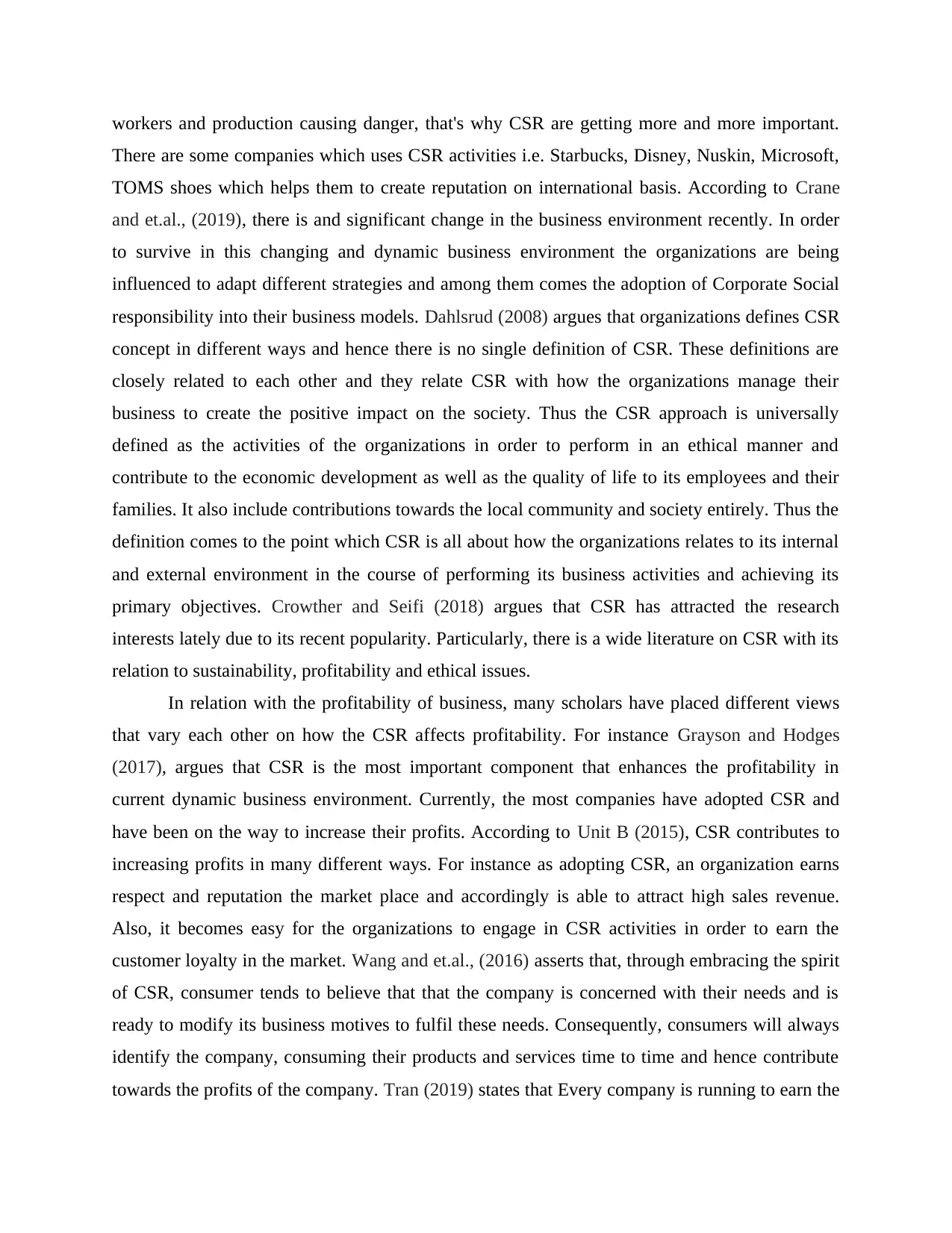
workers and production causing danger, that's why CSR are getting more and more important.
There are some companies which uses CSR activities i.e. Starbucks, Disney, Nuskin, Microsoft,
TOMS shoes which helps them to create reputation on international basis. According to Crane
and et.al., (2019), there is and significant change in the business environment recently. In order
to survive in this changing and dynamic business environment the organizations are being
influenced to adapt different strategies and among them comes the adoption of Corporate Social
responsibility into their business models. Dahlsrud (2008) argues that organizations defines CSR
concept in different ways and hence there is no single definition of CSR. These definitions are
closely related to each other and they relate CSR with how the organizations manage their
business to create the positive impact on the society. Thus the CSR approach is universally
defined as the activities of the organizations in order to perform in an ethical manner and
contribute to the economic development as well as the quality of life to its employees and their
families. It also include contributions towards the local community and society entirely. Thus the
definition comes to the point which CSR is all about how the organizations relates to its internal
and external environment in the course of performing its business activities and achieving its
primary objectives. Crowther and Seifi (2018) argues that CSR has attracted the research
interests lately due to its recent popularity. Particularly, there is a wide literature on CSR with its
relation to sustainability, profitability and ethical issues.
In relation with the profitability of business, many scholars have placed different views
that vary each other on how the CSR affects profitability. For instance Grayson and Hodges
(2017), argues that CSR is the most important component that enhances the profitability in
current dynamic business environment. Currently, the most companies have adopted CSR and
have been on the way to increase their profits. According to Unit B (2015), CSR contributes to
increasing profits in many different ways. For instance as adopting CSR, an organization earns
respect and reputation the market place and accordingly is able to attract high sales revenue.
Also, it becomes easy for the organizations to engage in CSR activities in order to earn the
customer loyalty in the market. Wang and et.al., (2016) asserts that, through embracing the spirit
of CSR, consumer tends to believe that that the company is concerned with their needs and is
ready to modify its business motives to fulfil these needs. Consequently, consumers will always
identify the company, consuming their products and services time to time and hence contribute
towards the profits of the company. Tran (2019) states that Every company is running to earn the
There are some companies which uses CSR activities i.e. Starbucks, Disney, Nuskin, Microsoft,
TOMS shoes which helps them to create reputation on international basis. According to Crane
and et.al., (2019), there is and significant change in the business environment recently. In order
to survive in this changing and dynamic business environment the organizations are being
influenced to adapt different strategies and among them comes the adoption of Corporate Social
responsibility into their business models. Dahlsrud (2008) argues that organizations defines CSR
concept in different ways and hence there is no single definition of CSR. These definitions are
closely related to each other and they relate CSR with how the organizations manage their
business to create the positive impact on the society. Thus the CSR approach is universally
defined as the activities of the organizations in order to perform in an ethical manner and
contribute to the economic development as well as the quality of life to its employees and their
families. It also include contributions towards the local community and society entirely. Thus the
definition comes to the point which CSR is all about how the organizations relates to its internal
and external environment in the course of performing its business activities and achieving its
primary objectives. Crowther and Seifi (2018) argues that CSR has attracted the research
interests lately due to its recent popularity. Particularly, there is a wide literature on CSR with its
relation to sustainability, profitability and ethical issues.
In relation with the profitability of business, many scholars have placed different views
that vary each other on how the CSR affects profitability. For instance Grayson and Hodges
(2017), argues that CSR is the most important component that enhances the profitability in
current dynamic business environment. Currently, the most companies have adopted CSR and
have been on the way to increase their profits. According to Unit B (2015), CSR contributes to
increasing profits in many different ways. For instance as adopting CSR, an organization earns
respect and reputation the market place and accordingly is able to attract high sales revenue.
Also, it becomes easy for the organizations to engage in CSR activities in order to earn the
customer loyalty in the market. Wang and et.al., (2016) asserts that, through embracing the spirit
of CSR, consumer tends to believe that that the company is concerned with their needs and is
ready to modify its business motives to fulfil these needs. Consequently, consumers will always
identify the company, consuming their products and services time to time and hence contribute
towards the profits of the company. Tran (2019) states that Every company is running to earn the
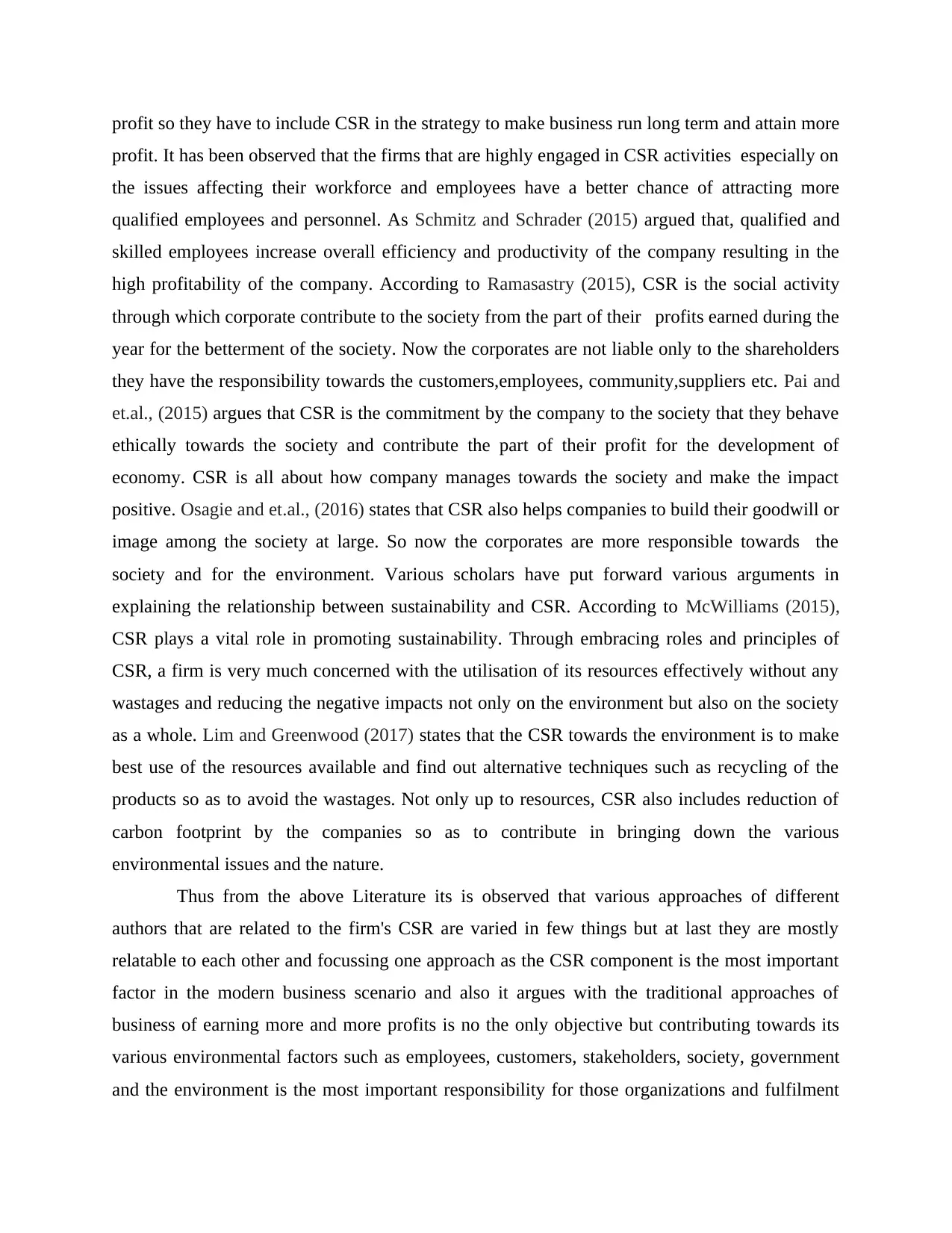
profit so they have to include CSR in the strategy to make business run long term and attain more
profit. It has been observed that the firms that are highly engaged in CSR activities especially on
the issues affecting their workforce and employees have a better chance of attracting more
qualified employees and personnel. As Schmitz and Schrader (2015) argued that, qualified and
skilled employees increase overall efficiency and productivity of the company resulting in the
high profitability of the company. According to Ramasastry (2015), CSR is the social activity
through which corporate contribute to the society from the part of their profits earned during the
year for the betterment of the society. Now the corporates are not liable only to the shareholders
they have the responsibility towards the customers,employees, community,suppliers etc. Pai and
et.al., (2015) argues that CSR is the commitment by the company to the society that they behave
ethically towards the society and contribute the part of their profit for the development of
economy. CSR is all about how company manages towards the society and make the impact
positive. Osagie and et.al., (2016) states that CSR also helps companies to build their goodwill or
image among the society at large. So now the corporates are more responsible towards the
society and for the environment. Various scholars have put forward various arguments in
explaining the relationship between sustainability and CSR. According to McWilliams (2015),
CSR plays a vital role in promoting sustainability. Through embracing roles and principles of
CSR, a firm is very much concerned with the utilisation of its resources effectively without any
wastages and reducing the negative impacts not only on the environment but also on the society
as a whole. Lim and Greenwood (2017) states that the CSR towards the environment is to make
best use of the resources available and find out alternative techniques such as recycling of the
products so as to avoid the wastages. Not only up to resources, CSR also includes reduction of
carbon footprint by the companies so as to contribute in bringing down the various
environmental issues and the nature.
Thus from the above Literature its is observed that various approaches of different
authors that are related to the firm's CSR are varied in few things but at last they are mostly
relatable to each other and focussing one approach as the CSR component is the most important
factor in the modern business scenario and also it argues with the traditional approaches of
business of earning more and more profits is no the only objective but contributing towards its
various environmental factors such as employees, customers, stakeholders, society, government
and the environment is the most important responsibility for those organizations and fulfilment
profit. It has been observed that the firms that are highly engaged in CSR activities especially on
the issues affecting their workforce and employees have a better chance of attracting more
qualified employees and personnel. As Schmitz and Schrader (2015) argued that, qualified and
skilled employees increase overall efficiency and productivity of the company resulting in the
high profitability of the company. According to Ramasastry (2015), CSR is the social activity
through which corporate contribute to the society from the part of their profits earned during the
year for the betterment of the society. Now the corporates are not liable only to the shareholders
they have the responsibility towards the customers,employees, community,suppliers etc. Pai and
et.al., (2015) argues that CSR is the commitment by the company to the society that they behave
ethically towards the society and contribute the part of their profit for the development of
economy. CSR is all about how company manages towards the society and make the impact
positive. Osagie and et.al., (2016) states that CSR also helps companies to build their goodwill or
image among the society at large. So now the corporates are more responsible towards the
society and for the environment. Various scholars have put forward various arguments in
explaining the relationship between sustainability and CSR. According to McWilliams (2015),
CSR plays a vital role in promoting sustainability. Through embracing roles and principles of
CSR, a firm is very much concerned with the utilisation of its resources effectively without any
wastages and reducing the negative impacts not only on the environment but also on the society
as a whole. Lim and Greenwood (2017) states that the CSR towards the environment is to make
best use of the resources available and find out alternative techniques such as recycling of the
products so as to avoid the wastages. Not only up to resources, CSR also includes reduction of
carbon footprint by the companies so as to contribute in bringing down the various
environmental issues and the nature.
Thus from the above Literature its is observed that various approaches of different
authors that are related to the firm's CSR are varied in few things but at last they are mostly
relatable to each other and focussing one approach as the CSR component is the most important
factor in the modern business scenario and also it argues with the traditional approaches of
business of earning more and more profits is no the only objective but contributing towards its
various environmental factors such as employees, customers, stakeholders, society, government
and the environment is the most important responsibility for those organizations and fulfilment
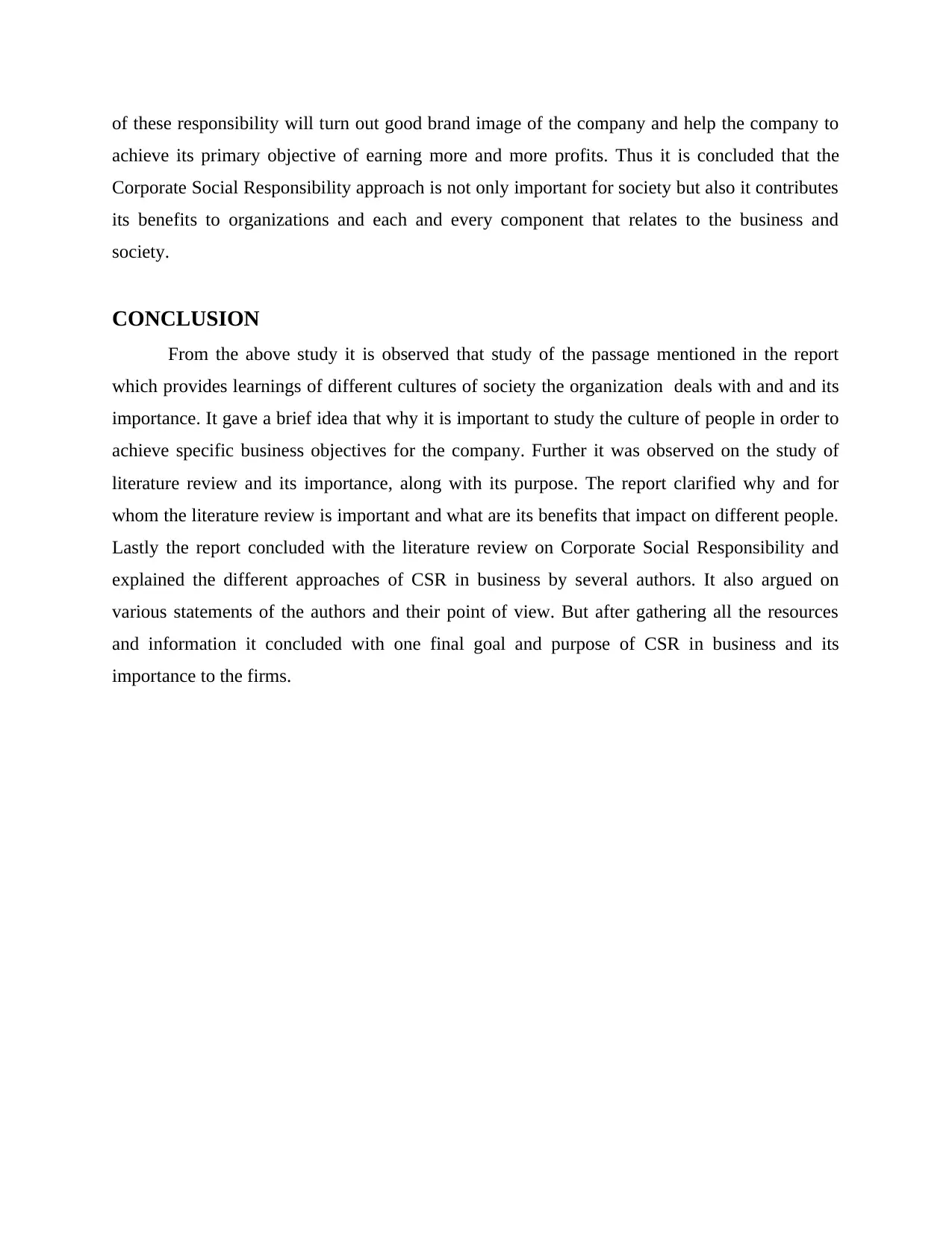
of these responsibility will turn out good brand image of the company and help the company to
achieve its primary objective of earning more and more profits. Thus it is concluded that the
Corporate Social Responsibility approach is not only important for society but also it contributes
its benefits to organizations and each and every component that relates to the business and
society.
CONCLUSION
From the above study it is observed that study of the passage mentioned in the report
which provides learnings of different cultures of society the organization deals with and and its
importance. It gave a brief idea that why it is important to study the culture of people in order to
achieve specific business objectives for the company. Further it was observed on the study of
literature review and its importance, along with its purpose. The report clarified why and for
whom the literature review is important and what are its benefits that impact on different people.
Lastly the report concluded with the literature review on Corporate Social Responsibility and
explained the different approaches of CSR in business by several authors. It also argued on
various statements of the authors and their point of view. But after gathering all the resources
and information it concluded with one final goal and purpose of CSR in business and its
importance to the firms.
achieve its primary objective of earning more and more profits. Thus it is concluded that the
Corporate Social Responsibility approach is not only important for society but also it contributes
its benefits to organizations and each and every component that relates to the business and
society.
CONCLUSION
From the above study it is observed that study of the passage mentioned in the report
which provides learnings of different cultures of society the organization deals with and and its
importance. It gave a brief idea that why it is important to study the culture of people in order to
achieve specific business objectives for the company. Further it was observed on the study of
literature review and its importance, along with its purpose. The report clarified why and for
whom the literature review is important and what are its benefits that impact on different people.
Lastly the report concluded with the literature review on Corporate Social Responsibility and
explained the different approaches of CSR in business by several authors. It also argued on
various statements of the authors and their point of view. But after gathering all the resources
and information it concluded with one final goal and purpose of CSR in business and its
importance to the firms.
Secure Best Marks with AI Grader
Need help grading? Try our AI Grader for instant feedback on your assignments.
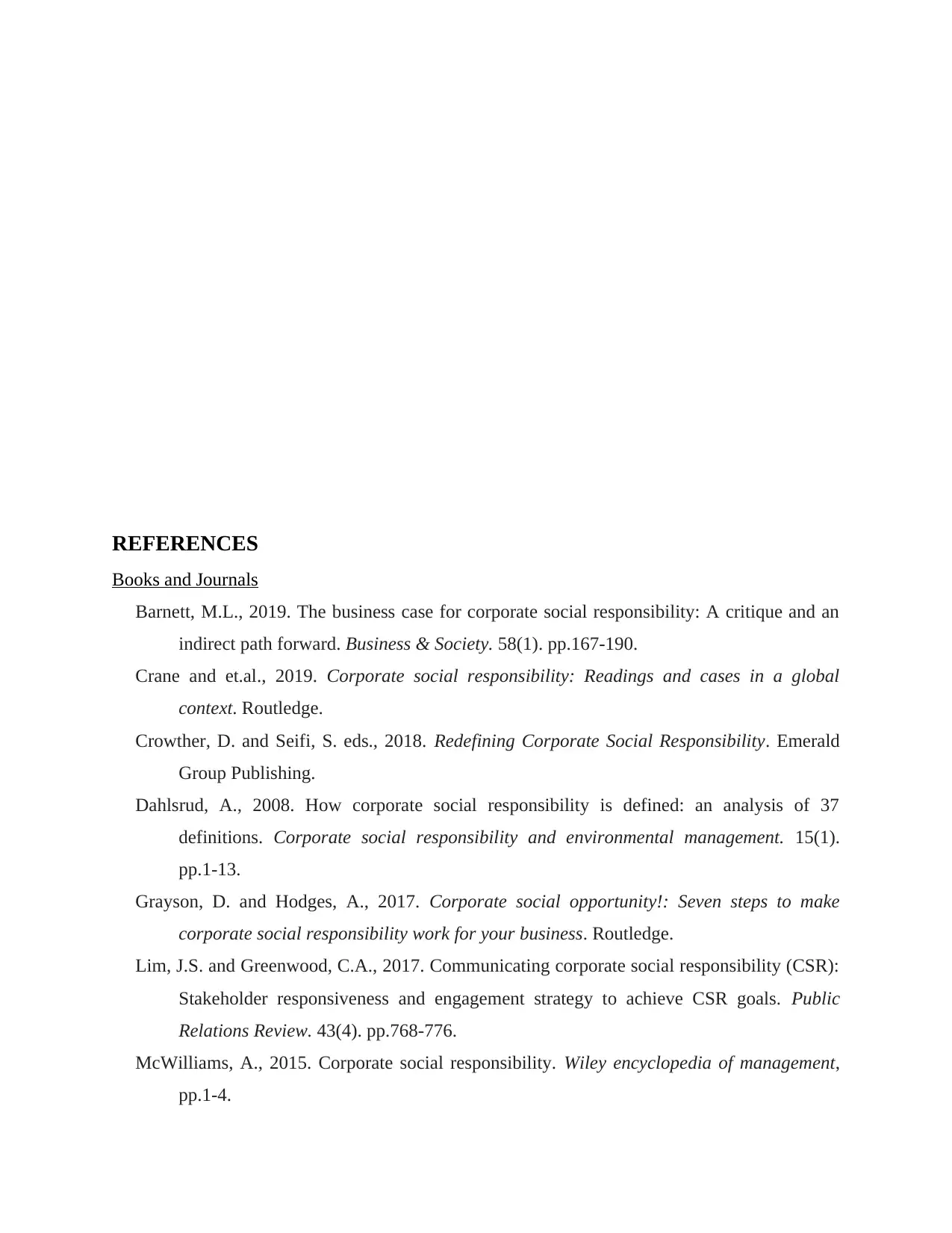
REFERENCES
Books and Journals
Barnett, M.L., 2019. The business case for corporate social responsibility: A critique and an
indirect path forward. Business & Society. 58(1). pp.167-190.
Crane and et.al., 2019. Corporate social responsibility: Readings and cases in a global
context. Routledge.
Crowther, D. and Seifi, S. eds., 2018. Redefining Corporate Social Responsibility. Emerald
Group Publishing.
Dahlsrud, A., 2008. How corporate social responsibility is defined: an analysis of 37
definitions. Corporate social responsibility and environmental management. 15(1).
pp.1-13.
Grayson, D. and Hodges, A., 2017. Corporate social opportunity!: Seven steps to make
corporate social responsibility work for your business. Routledge.
Lim, J.S. and Greenwood, C.A., 2017. Communicating corporate social responsibility (CSR):
Stakeholder responsiveness and engagement strategy to achieve CSR goals. Public
Relations Review. 43(4). pp.768-776.
McWilliams, A., 2015. Corporate social responsibility. Wiley encyclopedia of management,
pp.1-4.
Books and Journals
Barnett, M.L., 2019. The business case for corporate social responsibility: A critique and an
indirect path forward. Business & Society. 58(1). pp.167-190.
Crane and et.al., 2019. Corporate social responsibility: Readings and cases in a global
context. Routledge.
Crowther, D. and Seifi, S. eds., 2018. Redefining Corporate Social Responsibility. Emerald
Group Publishing.
Dahlsrud, A., 2008. How corporate social responsibility is defined: an analysis of 37
definitions. Corporate social responsibility and environmental management. 15(1).
pp.1-13.
Grayson, D. and Hodges, A., 2017. Corporate social opportunity!: Seven steps to make
corporate social responsibility work for your business. Routledge.
Lim, J.S. and Greenwood, C.A., 2017. Communicating corporate social responsibility (CSR):
Stakeholder responsiveness and engagement strategy to achieve CSR goals. Public
Relations Review. 43(4). pp.768-776.
McWilliams, A., 2015. Corporate social responsibility. Wiley encyclopedia of management,
pp.1-4.
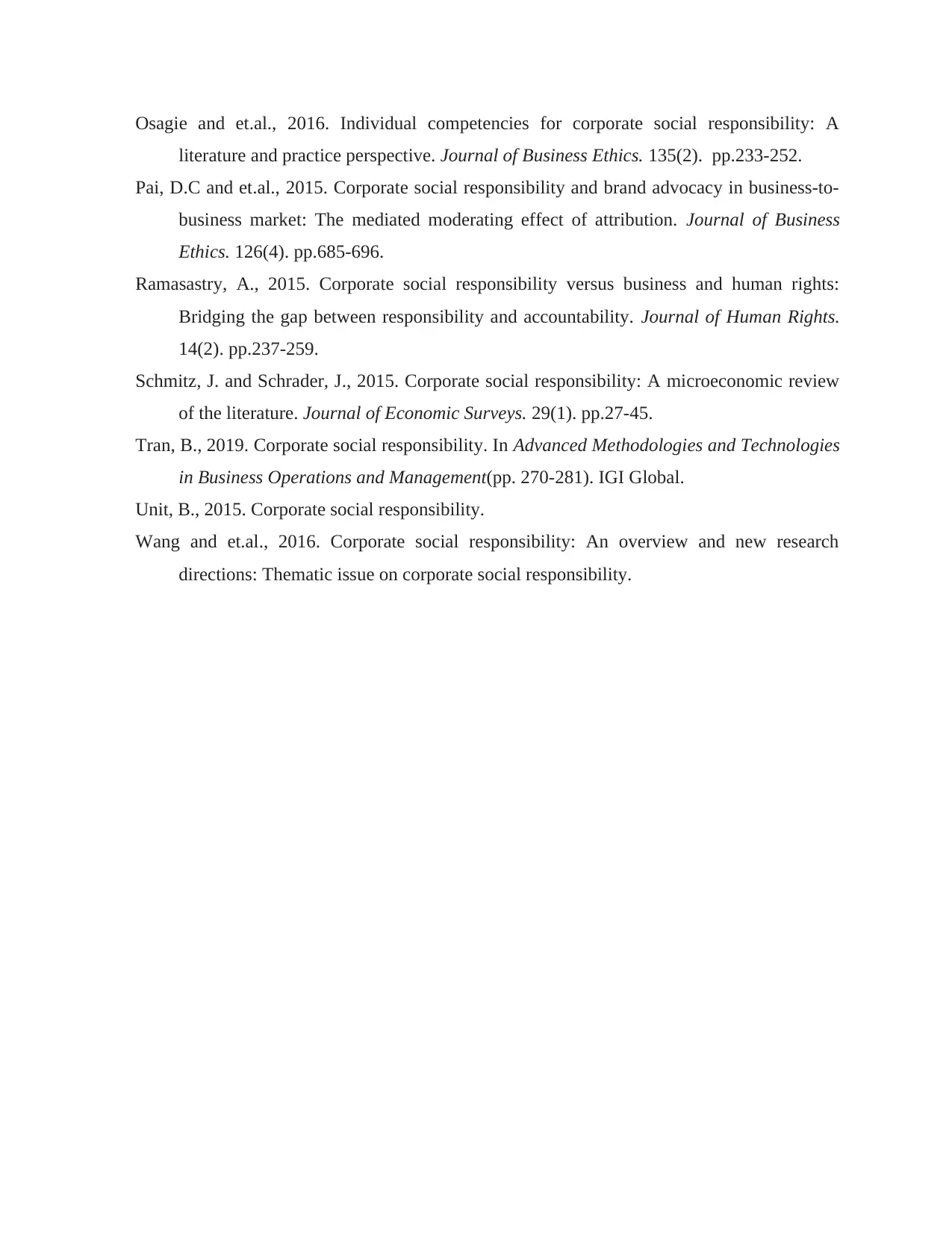
Osagie and et.al., 2016. Individual competencies for corporate social responsibility: A
literature and practice perspective. Journal of Business Ethics. 135(2). pp.233-252.
Pai, D.C and et.al., 2015. Corporate social responsibility and brand advocacy in business-to-
business market: The mediated moderating effect of attribution. Journal of Business
Ethics. 126(4). pp.685-696.
Ramasastry, A., 2015. Corporate social responsibility versus business and human rights:
Bridging the gap between responsibility and accountability. Journal of Human Rights.
14(2). pp.237-259.
Schmitz, J. and Schrader, J., 2015. Corporate social responsibility: A microeconomic review
of the literature. Journal of Economic Surveys. 29(1). pp.27-45.
Tran, B., 2019. Corporate social responsibility. In Advanced Methodologies and Technologies
in Business Operations and Management(pp. 270-281). IGI Global.
Unit, B., 2015. Corporate social responsibility.
Wang and et.al., 2016. Corporate social responsibility: An overview and new research
directions: Thematic issue on corporate social responsibility.
literature and practice perspective. Journal of Business Ethics. 135(2). pp.233-252.
Pai, D.C and et.al., 2015. Corporate social responsibility and brand advocacy in business-to-
business market: The mediated moderating effect of attribution. Journal of Business
Ethics. 126(4). pp.685-696.
Ramasastry, A., 2015. Corporate social responsibility versus business and human rights:
Bridging the gap between responsibility and accountability. Journal of Human Rights.
14(2). pp.237-259.
Schmitz, J. and Schrader, J., 2015. Corporate social responsibility: A microeconomic review
of the literature. Journal of Economic Surveys. 29(1). pp.27-45.
Tran, B., 2019. Corporate social responsibility. In Advanced Methodologies and Technologies
in Business Operations and Management(pp. 270-281). IGI Global.
Unit, B., 2015. Corporate social responsibility.
Wang and et.al., 2016. Corporate social responsibility: An overview and new research
directions: Thematic issue on corporate social responsibility.
1 out of 12
Related Documents
Your All-in-One AI-Powered Toolkit for Academic Success.
+13062052269
info@desklib.com
Available 24*7 on WhatsApp / Email
![[object Object]](/_next/static/media/star-bottom.7253800d.svg)
Unlock your academic potential
© 2024 | Zucol Services PVT LTD | All rights reserved.





